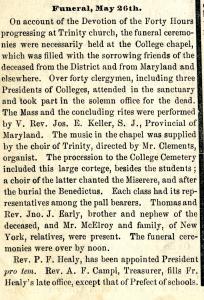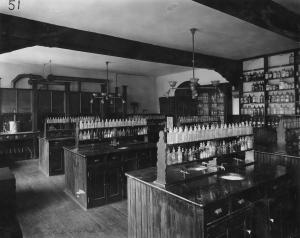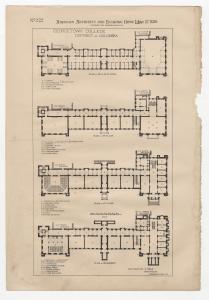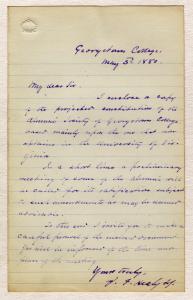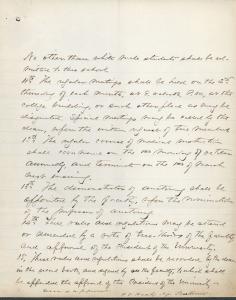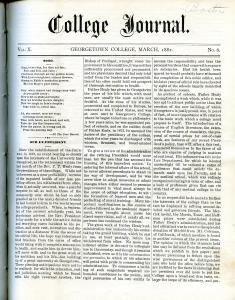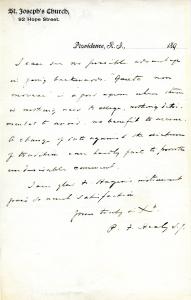Father Patrick Healy first came to Georgetown in 1858 to study philosophy and theology. Returning in 1866 as a faculty member, he became Prefect of Studies (Dean of the College) three years later. On May 23, 1873, he was appointed as acting Georgetown President. The acting portion of his title was removed on July 31, 1874, and this exhibition celebrates the 150th anniversary of that event, as well as the many and significant contributions he made to the University.
Father Healy is one of Georgetown’s most dynamic presidents and is credited with beginning the transformation of the school from a small liberal arts college to a modern university. By the time he resigned for health reasons in 1882, he had doubled the square footage of campus facilities, reshaped and modernized our curriculum, and regularized methods of fundraising. These accomplishments have led some historians to term him Georgetown’s second founder.
Patrick F. Healy, S.J. Photograph by C.M. Bell, around 1873
Born in Macon, Georgia, in 1834, Patrick was the third son of Michael Morris Healy, an Irish immigrant who owned a plantation, and Mary Eliza, an enslaved woman. His father sent him and his brothers north to be educated at the College of the Holy Cross in Massachusetts, in the hope that they could escape the threat of enslavement. In Georgia, Patrick and his siblings were classed as enslaved and his father was prevented by state law from emancipating either them or their mother to whom he seems to have been deeply devoted. Fr. Healy entered the Jesuit Order after graduating from Holy Cross in 1850.
“Funeral [of Georgetown President John Early, S.J.], May 26th.” Georgetown College Journal, June 1873 supplement. Includes announcement of appointment of Patrick Healy as Georgetown President pro tem
Father Healy was appointed as acting Georgetown President on May 23, 1873, after the sudden death of President John Early, S.J. Letters between Jesuit officials at this time mention the problem related to his [Father Healy’s] background and the difficulty. These comments suggest concern that Father Healy’s biracial background might prove problematic in the role of head of a significant institution in a southern city. This concern led to his initial appointment as President in an acting capacity. He was made full President more than a year later, on July 31,1874.
Chemistry Lab in Healy Hall
President Healy revamped and modernized Georgetown’s curriculum, increasing the number of science classes offered and placing more emphasis on the study of English literature. Before his reforms, only seniors could take science classes; after them, sophomores studied chemistry and physiology and juniors were introduced to organic chemistry and mechanics. In 1875, he created a three year non-classical program for students who wanted to focus on English literature, mathematics, science and modern languages, and the degree of Bachelor of Science was awarded for the first time in 1879.
Concept drawing for Healy Hall by J.L. Smithmeyer & Pelz, 1877
Father Healy’s expanded curriculum required an expansion of facilities as we needed more lab space and a larger library to support it. Before he was made President, there had been plans to build multiple new buildings on campus in the same architectural style as existing ones. He abandoned those plans and constructed one large building in a very different style, which has been described as Neo-Gothic/Medieval Revival. The cornerstone for the building, later named Healy Hall, was laid on December 12, 1877.
President Healy clearly wanted the building to stand out. And it stood out in terms of physical orientation as well as architectural style. As R. Emmett Curran writes in his History of Georgetown University, vol. 1: For the first time in its history the university was constructing a building that fronted not the river but the city, as if to state visually its intention of becoming an enduring Catholic university in the capital city of the United States.
Floor plan for Healy Hall by Smithmeyer & Pelz, Architects. American Architect and Building News, March 27, 1880 (Gift of Richard J. Cellini, C’1984, L’1988)
The firm of J.L. Smithmeyer & Co, who designed the main building of the Library of Congress, designed Healy Hall. The building is massive in scale - at 312 feet long and 95 feet wide, with a clock tower that rises 200 feet. Its completion more than doubled the total square footage of campus buildings.
In addition to classrooms, science labs, a library (Riggs), a museum, an office for the University President, and an auditorium (Gaston Hall), Healy Hall offered private dorm rooms on its 3rd and 4th floors. Before the building opened, all dorms on campus were open and communal, an arrangement disliked by many older students - some even left citing that as the reason.
Circular letter from President Healy to alumni announcing the creation of the Alumni Society of Georgetown College, May 3rd, 1880
I enclose a copy of the projected constitution of the Alumni Society of Georgetown College, based mainly upon the one that now obtains in the University of Virginia.
In a short time a preliminary meeting of some of the Alumni will be called for its ratification subject to such amendments as may be deemed advisable.
To this end I invite you to make a careful perusal of the enclosed document. You will be informed of the time and place of the meeting.
Yours truly
P.F. Healy S.J.
Patrick Healy was instructed by Jesuit superiors to spend no more than $100,000 on Healy Hall. By 1882, he had spent $437,000 and the building was unfinished. The University borrowed money to pay for construction and then, to repay those loans, had to lease campus land to local farmers, lay off staff, and sell 76 acres of land it owned on the north side of Reservoir Road.
In an effort to improve the financial situation, President Healy initiated Georgetown’s first fundraising campaign since 1787, when John Carroll had solicited donations to start the school. As part of his efforts, he invited a group of alumni to form an Alumni Society. The group held its first reunion at commencement in 1881. President Healy arranged for them to sleep in the then unfinished Gaston Hall - perhaps to provide them with motivation to raise money to complete the building.
Last page of Rules and Regulations adopted by the Medical Faculty of the University of Georgetown, ca. 1881
Noted at the bottom as Seen & approved by P. F. Healy, S.J., this page starts with a statement on admissions: No other than white male students shall be admitted to this school. Neither the Jesuit Order nor Father Healy publicly acknowledged his biracial background during his life and no African Americans were admitted to Georgetown while he was President.
"Our Ex-President." Student tribute to Father Healy on his resignation as University President. Georgetown College Journal, March 1882
Fr. Healy traveled almost constantly between December 1878 and June 1880 to raise funds for Healy Hall’s completion. This intense, and at times physically taxing, work adversely impacted his health and he resigned on February 16, 1882. Never fully recovering, he spent the next three decades engaged in limited pastoral work in New York and in Washington, D.C.
Page 2 of letter from Father Healy to GU President J. Havens Richards, S.J., ca. June 1894
Even after he resigned as President, Father Healy continued to be involved in University issues as his successors sought his opinions. An example is seen here. This letter is Father Healy's reply to one sent by President Richards asking for advice about a suggestion by alumnus John Agar that it was incorrect to use 1789 as the University’s founding year. Agar’s suggestion, rooted in some historical validity, came only five years after Georgetown had celebrated its Centennial in 1889. Father Healy’s response was pragmatic and to the point. He advocated for the continued use of 1789 as the founding date: I can see no possible advantage in going backwards . . . a change of date against the dictum of tradition can hardly fail to provoke undesirable comment.
Service at Father Healy’s restored tombstone in Georgetown’s Jesuit Community Cemetery, March 27, 1974. C.L. Stankiewicz, S.J. Rector of the Jesuit Community, is seen far right
Father Healy died in Georgetown’s infirmary on January 19, 1910, and was buried in the Jesuit Community Cemetery on campus. In 1974, his weathered tombstone was restored by the Patrick Healy Commemorative Committee which was established to observe the 100th anniversary of his becoming full University President in 1874.
Curated by Lynn Conway, University Archivist
Exhibition suggested by Julian Jimenez, CAS ' 24


